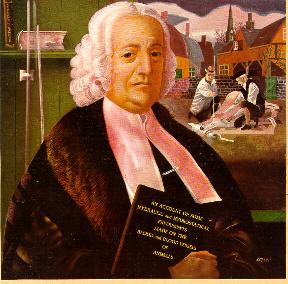Stephen Hales and Sunlight
Dennis P. Valenzeno
Associate Dean for Medical Sciences
Chair and Professor of the Department of Medical Sciences
The University of Kansas Medical Center - Wichita
1010 N. Kansas St., Wichita, KS 67214-3199
dvalenzeno@kumc.edu
(Reprinted from an article in the ASP Newsletter
No. 124, Dec/Jan 1989-90)
Reverend Dr. Stephen Hales, an English clergyman, is perhaps best remembered for his dramatic demonstration of blood pressure. Most medical students hear of how he attached a glass tube to an artery of a horse and watched blood rise to a height of 8 feet 3 inches. But, Hales's interest in photobiology is less well appreciated. In fact, he expended considerable effort in the study of the effects of sunlight on growing plants. In contrast to the thinking of his day, he concluded that apart from the generation of heat, sunlight also exerted some "direct" effect on growing plants. In Vegetable Staticks Hales comments, "And may not light also ... contribute much to the ennobling the principles of vegetables". He combines this with a quote from Sir Isaac Newton to indicate that light and matter are indeed interconvertible and that light may enter into the composition of bodies.

Figure 1. The Reverend Dr. Stephen Hales is best remembered for making the first measurement of blood pressure. Courtesy of the Clendening History of Medicine Library, University of Kansas Medical Center.
These interests of Stephen Hales are recounted in an article by Howard Gest (1988) entitled "Sun-beams, cucumbers and purple bacteria: Historical milestones in early studies of photosynthesis revisited". The story of the purple bacteria will have to wait for another column, but let us consider Hales' involvement with cucumbers and with Jonathan Swift's Gulliver's Travels. According to Gest, and others, Hales' work appears to have been the basis for one of the satirical experiments presented in the fifth chapter of part III of Gulliver's Travels. In the Academy of Lagado, a parody of the Royal Society of London, one of the resident scientists is busily involved in his 8 year old project of "extracting Sun-Beams out of Cucumbers, which were to be put into Vials hermetically Sealed, and let out to warm the Air in raw inclement Summers". According to Gest, the demonstration that sunlight is required for the synthetic activity of plants was still 50 years in the future. Swift appears to have seized on Hales' presentation to the Royal Society, embellishing it to produce what he perceived as a ludicrous notion. The irony, of course, is that in burning vegetable matter and in processes such as fermentation, man has unknowingly been "extracting sunbeams" from plants for ages.
Reference
Howard Gest. 1988. Photosyn. Res. 19, 287-308.